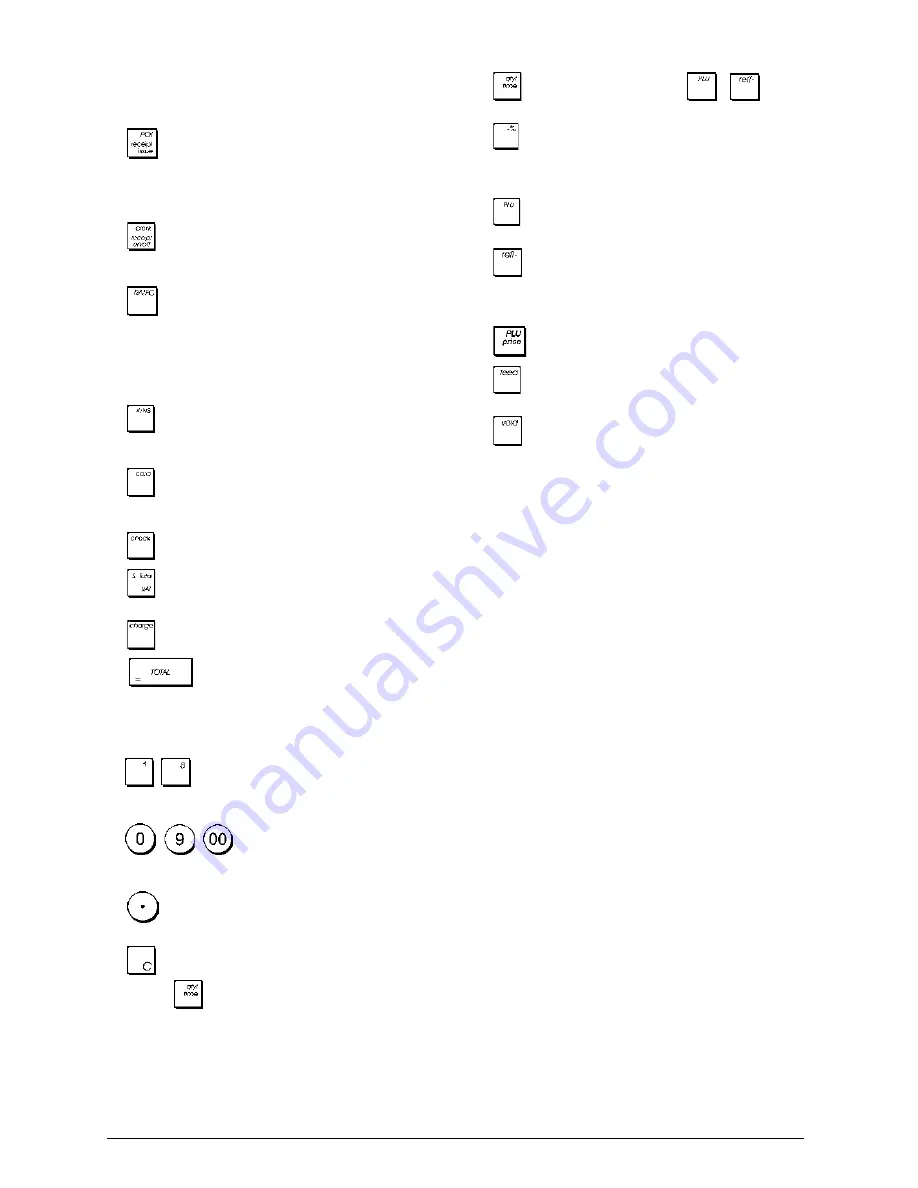
2
Keypad Functions
With reference to figure 5:
1.
- Registers any money taken out of the cash
drawer that is not part of a sale. When pressed in the R2
mode, prints one or more copies of the last sales translation
recorded (overrides the Receipt Off mode set with the
related key).
2.
- Confirms an entered clerk number and three-digit
security code. In the R2 mode, toggles the cash register
between printing and not printing the sales receipt.
3.
- When used as the RA key, registers any money
received on account that is not part of a sale; for example,
the start-up money put in the drawer at the start of each
business day can be registered as an RA. As the
Currency Conversion key, it is used to automatically
calculate and display the value in foreign currency of the
subtotal of a sale or of a particular amount registered.
4.
- Opens the cash drawer without registering any
amount or when changing cash for a non-sales
transaction.
5.
- Registers sales that are put on credit, such as a
debit card, or on a credit card that is alternative to the one
used for Charge tenders.
6.
- Registers sales paid by check.
7.
- Subtotals a sale, and used for the programming of
VAT rates.
8.
- Registers sales that are charged.
9.
- Totals exact cash transactions, computes
change and totals transactions that are split tendered
with check or credit card and cash together. This key is
also used to enter into the calculator mode. In the calculator
mode, it is used as the "equal" (=) key.
10.
-
- Departments 1 through 8, to enter single or
multiple item sales to a particular department. Department
keys 1, 2, 5 and 6 are also used in the calculator mode.
11.
-
/
- Input amounts, indicate how many
times a particular item repeats, add and subtract
percentage rates and input department code numbers.
12.
- Enters a decimal point for defining quantities with
decimals during sales transactions.
13.
- Clears an entry made from the numeric keypad
or with
before finalizing a transaction with a
Department or function key. Also used to clear error
conditions.
14.
- Multiplies [DEPARTMENT],
or
entries
and displays the current time in the R1 and R2 modes.
15.
- Used to subtract a percentage rate from an
individual item or an entire sale. The rate can be a pre-
programmed percentage rate or any other manually
entered percentage rate.
16.
- Registers a preset price of an individual item to the
appropriate department.
17.
- When used as the coupon key, subtracts an amount
from an item or the sales total, such as a coupon deduction.
When used as the Refund key, subtracts an item that is
returned for refund.
18.
- Used to manually enter a price for a PLU article.
19.
- Advances the receipt or journal paper one line
feed; advances the paper continuously when held down.
20.
- Deletes the last item entered, and used for
correcting a particular entry after it is processed and
printed.
During caption programming, cancels from right
to left the characters that have been entered.
The Control Dial
This dial must be properly positioned to operate the cash
register, to set the programs and to print or reset the totals for
the management report. With reference to figure 3:
1. Turn the control dial to the required position as indicated
below.
OFF
The cash register is turned off and cannot be
used.
JRNL (On/Journal Tape) - The cash register is set for
standard sales transactions. A journal record is
printed for each transaction. The key-activated
Receipt On/Off function does not work in this
mode (transaction always printed).
REG
(On/Customer Receipt) - The cash register is set
for standard sales transactions. A customer
receipt is printed for each transaction.
X1/X2 Prints the X management (mid-day) report.
Z1/Z2 Prints the Z management (end-of-day) report and
resets totals (except the grand total) to zero.
PRG
Used to set and change program settings.

























